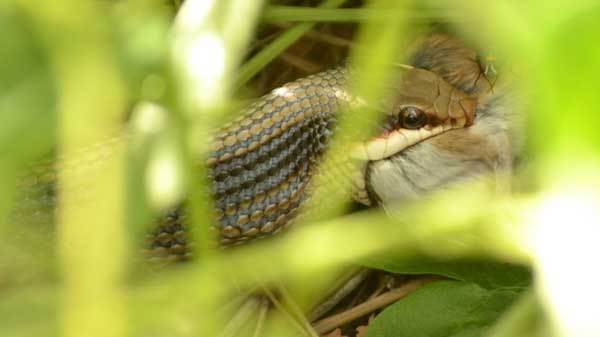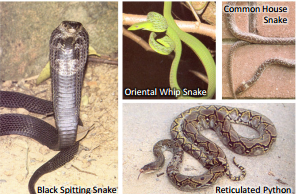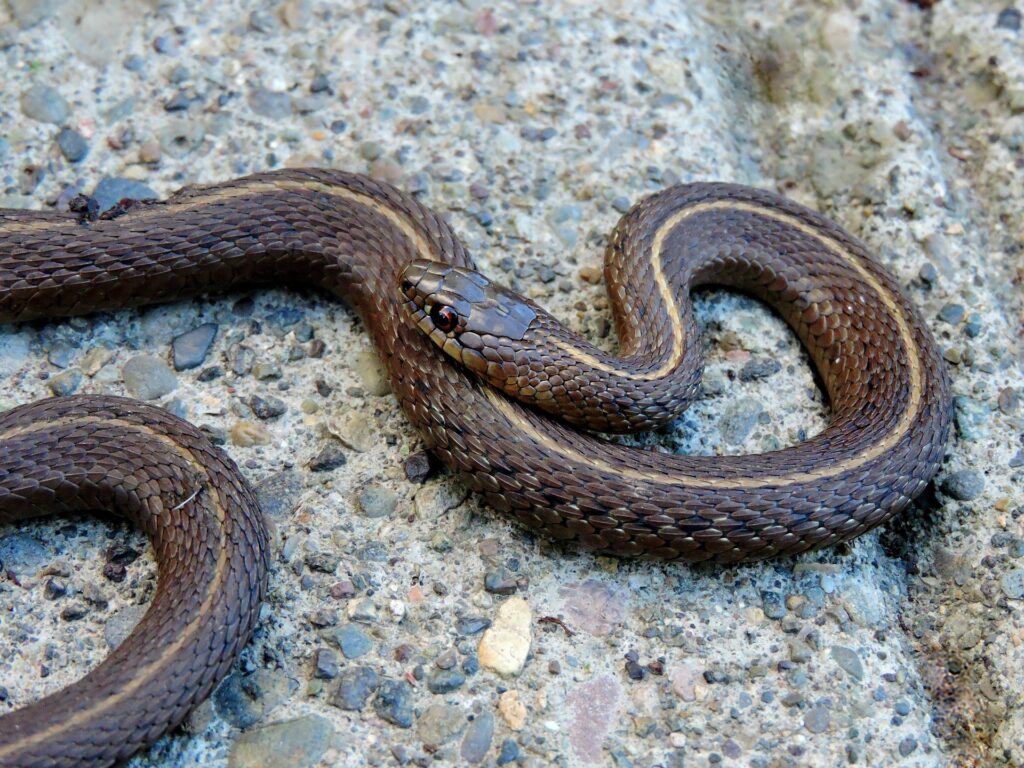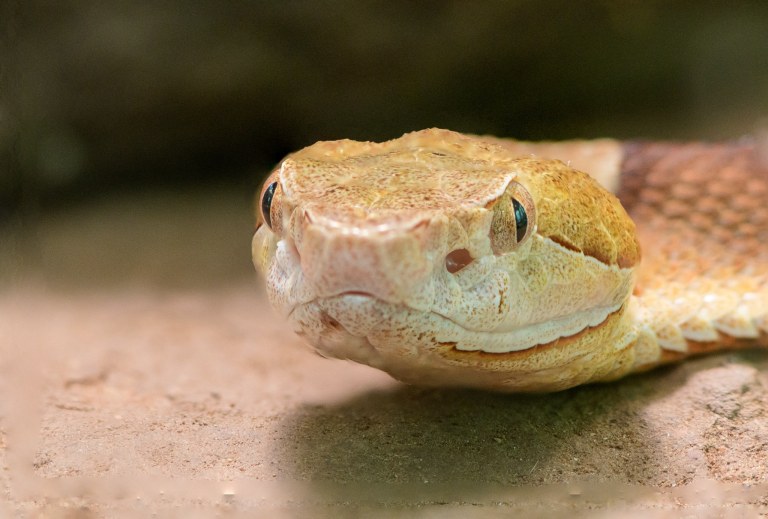The dos and don’ts of snake safety
Most snake bites occur when a snake is handled or accidentally touched by someone walking or climbing. Rattlesnakes, water moccasins and copperhead snakes are responsible for the overwhelming majority of venomous snake bites
Although most snakes are not aggressive and will slither away at the first hint of human presence, people should still take precautions to lessen the chance of being bitten – particularly in wooded areas around lakes or ponds.
MITIGATING THE HAZARD
Here are some tips to help mitigate the hazard of incurring a venomous snake bite.
• Use the buddy system when walking or running on trails near wooded areas.
• Do not step or put your hands where you cannot see.
• Wear over-the-ankle boots, thick socks and long loose pants, especially when venturing off of heavily used trails.
• Tap ahead of you with a walking stick before entering an area where you can’t see your feet. Snakes will try to avoid you if given enough warning.
• When possible, step on logs and rocks, never over them as you may surprise a sheltering snake.
• Avoid walking through dense brush or blackberry thickets.
• Be careful when stepping over a doorstep. Snakes like to crawl along the edge of buildings where they are protected on one side.
• Avoid wandering around in the dark. If you are out at night, always use a flashlight, because most snakes are active on warm nights.
• Never try to pick up a snake, even if it is dead. A snake’s reflexes can still cause the snake to strike up to an hour after it has died.
• If you have an encounter with a snake, give it the right-of-way. Do not attempt to kill the snake, just move out of the snake’s way.
• If you encounter a snake in the housing area or in your yard, call the police desk and follow their instructions.
• If you hike often, consider buying a snake bite kit – available from hiking supply stores. Do not use older snake bite kits, such as those containing razor blades and suction bulbs.
WHAT TO DO IF BITTEN
Despite taking all safety precautions, we cannot completely eliminate the hazard, so it is a good idea to have a plan about what to do in the event you, your child, or a buddy is bitten by a snake. When it comes to treating a venomous snake bite, the most important thing to do is get to a medical facility as quickly as possible.
the following first aid measures:
• Keep the person calm, reassuring them that bites can be effectively treated in an emergency room. Restrict movement. Immobilize the site and keep it below heart level to reduce the flow of venom.
• Remove any rings or constricting items because the affected area may swell. Create a loose splint to help restrict movement of the area.
• Bring in the dead snake only if this can be done safely. Do not waste time hunting for the snake, and do not risk another bite if it is not easy to kill the snake. Be careful of the head when transporting it – a snake can actually bite for up to an hour after it’s dead.
• If you have a pump suction device (such as that made by Sawyer), follow the manufacturer’s directions.

Snakes
What to do when there is a snake in the house?
Resist the urge to attack it with a broom or stick. Do not confront the snake and keep your distance away from the snake. The snake may try to look for a dark and secure area and you should observe to see where it hides, so that it can be removed by professionals.
Make sure that young children and pets like dogs or cats are kept away from the room or area where the snake is, as they may be curious and try to approach the snake.
Close all doors in the room, except for those that lead to the outside like your balcony, patio or front doors. Sometimes the snake will look for an escape route and will use these openings.
If the snake is in the garden, spray it gently with a water hose to send it on its way while keeping your distance. This will persuade the snake to leave the area. If you find a snake in your pool, you can use a long handled leaf skimmer to gently remove the snake, as it may not be able to get out on its own if it is small or exhausted from swimming.
If the snake is in an open area like the floor and not moving much, the best thing to do is to place an object over it like a heavy blanket or towel. Hold the towel/blanket in front of you when approaching it, and then firmly cast it over the snake. The snake should immediately calm down and will feel secure if it cannot see what is going on outside the blanket. If possible, place heavy objects around the edge to prevent the snake from slipping out from underneath the towel/blanket and escaping. This will buy you some time to get help.
If the snake is found in a drawer, behind furniture or somewhere difficult to access, leave it alone; move all family members away from the immediate area and, most of all, do not attempt to interact with it at all. Call for professional help. Have someone to keep an eye on the snake from a safe distance and note where it goes into hiding while you are contacting for help.
Next, find out why the snake came to your area. Do you keep rodents or birds? Are there birds nesting in your garden, do you have a rodent problem in the house or garden? Some snakes prey on small mammals like rabbits, rats and cats, as well as birds and amphibians.

How to Get Rid of Snakes in Yard & House
Get Rid of Those Snakes!
Whether you are enjoying your yard or are in your home, it can be shocking coming face-to-face with a scaly, unexpected house guest. Snakes aren’t your typical house pest. They are harmless when they aren’t infesting your home or hiding away on your property. Most species will leave us alone – but they can be temperamental if approached.
Though snakes are good for the ecosystem and keeping rodent populations low, these slithering reptiles can be quite destructive and even deadly. Before you attempt to “charm” your visitor away from your home, which is not recommended unless you are a professional, here is some information about common snakes and nine tips on how to deal with them.
There are over 3,000 species of snakes around the world, but there are a few prominent types that tend to live. While these species can be spotted in other areas, the kind you find will likely depend on your surroundings. If you are near a body of water, the forest, or in a dryer area, the type of snake you may encounter will be different. While it is possible to be bitten by snakes, it should be noted that snakes are not poisonous – they are venomous. This means they can only transfer venom through a bite
To get a better idea of what you may be dealing with, here are the most common reptiles:
Garter: Often called the garden snake. Their most notable feature comes in yellow lines on their bodies. These snakes are mildly venomous, but it is not harmful to humans. They tend to live in grasslands and can be gray, red, black, or brown.
Copperhead: Semi-aquatic, venomous snakes. They live in marshes, wetlands, or similar areas. They are typically copper-colored, with reddish-brown bodies. If bitten, you will need an anti-venom.
Rattle Snakes: Known for their rattling tale. These venomous snakes have interlocking scales and will rattle their tail to you as a warning. They are generally light brown with dark brown spots.
Water Snake: Non-venomous snakes with aggressive behavior. Their typical habitat is near water. They can grow to about five feet long and have a rounder head than other snake species.
Keep Grass Trim and Clean
Snakes seek warm, moist areas with a food source. They also look for areas abundant in rodents. These reptiles like places to hide, and an overgrown yard is just the perfect place. An excellent way to discourage snakes populations is by keeping your grass cut. Additionally, if you routinely trim your lawn, you won’t run into any unexpected dangers while doing so.

venomous snakes and how to react if you see one
Copperhead – Agkistrodon contortrix
Status: Lowest conservation concern
Range in: Common statewide
Fun fact: Since copperhead venom dissolves tissue, researchers are working on synthesizing the protein in the venom in order to fight cancer.
Cottonmouth – Agkistrodon piscivorus
Status: Lowest conservation concern
Also known as: Water moccasin
Range in: Common throughout the state
Fun fact: Cottonmouths are the only venomous semi-aquatic snake in North America.
As long as you know how to react, an encounter with one of venomous snakes is not necessarily dangerous.
During walks in the woods, wear closed-toe shoes and long pants .
Additionally, look 3 to 5 feet ahead of you to avoid accidentally stepping on a snake.
Don’t put your hands or feet anywhere that you cannot fully see. Avoid sticking your hands in rocky outcroppings, piles of brush, or under tree stumps.
If you encounter a snake that might be venomous, slowly walk away
Additionally, if you find a snake on your property–ask yourself why the snake is there. More than likely, your property is prime real estate to snakes. Here are a couple of tips to make your yard less ideal for snakes.
Keep your lawn mowed and cleared of brush and branches.
Don’t leave pet food outside. Pet food attracts rodents, which then attracts snakes.
What to do if you are bitten by a snake
According to the Center for Disease Control, there are roughly 8,000 recorded snake bites in the United States every year. However, only about five end up being fatal. As long as you seek immediate medical attention, a snakebite is not a death sentence.

Snakes of Connecticut
Snakes Are Fascinating!
They survive in some of the most extreme environments on Earth and occur in a variety of habitats everywhere around the world
Snakes Are Reptiles
They are long and slender, covered with scales, and have no limbs. The scales can come in various shapes and can either be keeled (with a raised ridge down the center) or smooth (without the ridge). The wide scales on a snake’s belly are called ventral scales.
Snakes Are Ectothermic (cold-blooded)
Their body temperature changes with the temperature around them. A snake will bask in the sun to warm up or it will take refuge in a cool, shady spot when the weather is hot. In colder environments, snakes will brumate during winter. Unlike hibernation when animals are asleep, brumating animals are awake but inactive.
Snakes Cannot Blink their Eyes
The eyes are covered with a clear protective membrane called a spectacle.
Snakes Are Carnivores
They eat other animals, such as mice, birds, fish, frogs, insects, and even other snakes.
Moving Like a Snake
Despite a lack of limbs, snakes have developed a variety of ways to move and get around. Snakes have a flexible spine made up of 200-400 vertebrae, each of which is attached to a pair of separate, thin ribs. Most snakes move in a series of S-shaped curves, pushing themselves along using plants, rocks, sticks, and other surfaces as shove-off points. A few desert snakes move using a complicated series of sideways body twists (known as sidewinders). Some snakes are also very adept at swimming in water.